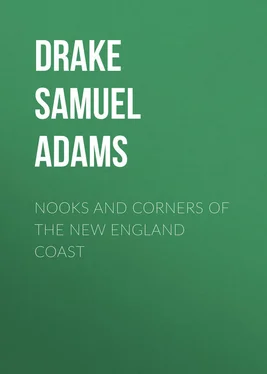Samuel Drake - Nooks and Corners of the New England Coast
Здесь есть возможность читать онлайн «Samuel Drake - Nooks and Corners of the New England Coast» — ознакомительный отрывок электронной книги совершенно бесплатно, а после прочтения отрывка купить полную версию. В некоторых случаях можно слушать аудио, скачать через торрент в формате fb2 и присутствует краткое содержание. Жанр: foreign_antique, foreign_prose, на английском языке. Описание произведения, (предисловие) а так же отзывы посетителей доступны на портале библиотеки ЛибКат.
- Название:Nooks and Corners of the New England Coast
- Автор:
- Жанр:
- Год:неизвестен
- ISBN:нет данных
- Рейтинг книги:3 / 5. Голосов: 1
-
Избранное:Добавить в избранное
- Отзывы:
-
Ваша оценка:
- 60
- 1
- 2
- 3
- 4
- 5
Nooks and Corners of the New England Coast: краткое содержание, описание и аннотация
Предлагаем к чтению аннотацию, описание, краткое содержание или предисловие (зависит от того, что написал сам автор книги «Nooks and Corners of the New England Coast»). Если вы не нашли необходимую информацию о книге — напишите в комментариях, мы постараемся отыскать её.
Nooks and Corners of the New England Coast — читать онлайн ознакомительный отрывок
Ниже представлен текст книги, разбитый по страницам. Система сохранения места последней прочитанной страницы, позволяет с удобством читать онлайн бесплатно книгу «Nooks and Corners of the New England Coast», без необходимости каждый раз заново искать на чём Вы остановились. Поставьте закладку, и сможете в любой момент перейти на страницу, на которой закончили чтение.
Интервал:
Закладка:
Samuel Adams Drake
Nooks and Corners of the New England Coast
CHAPTER I.
NEW ENGLAND OF THE ANCIENTS
"This is the forest primeval. The murmuring pines and the hemlocks,
Bearded with moss, and with garments green, indistinct in the twilight,
Stand like Druids of Old, with voices sad and prophetic,
Stand like harpers hoar, with beards that rest on their bosoms.
Loud from its rocky caverns the deep-voiced neighboring ocean
Speaks, and in accents disconsolate answers the wail of the forest."
In many respects the sea-coast of Maine is the most remarkable of New England. It is serrated with craggy projections, studded with harbors, seamed with inlets. Broad bays conduct to rivers of great volume that annually bear her forests down to the sea. Her shores are barricaded with islands, and her waters teem with the abundance of the seas. Seen on the map, it is a splintered, jagged, forbidding sea-board; beheld with the eye in a kindly season, its tawny headlands, green archipelagos, and inviting harbors, infolding sites recalling the earlier efforts at European colonization, combine in a wondrous degree to win the admiration of the man of science, of letters, or of leisure.
Maine embraces within her limits the semi-fabulous Norumbega and Mavoshen of ancient writers. Some portion of her territory has been known at various times by the names of Acadia, New France, and New England. The arms of France and of England have alternately been erected on her soil, and the flags of at least four powerful states have claimed her subjection. The most numerous and warlike of the primitive New England nations were seated here. Traces of French occupation are remaining in the names of St. Croix, Mount Desert, Isle au Haut, and Castine, names which neither treaties nor national prejudice have been quite able to eradicate.
The name of Norumbega, or Norembegue, the earliest applied to New England, is attributed to the Portuguese and Spaniards. Jean Alfonse, the pilot of Roberval, the same person who is accredited with having been first to navigate the waters of Massachusetts Bay, gives them the credit of its discovery. It is true that Marc Lescarbot, the Parisian advocate whose relations are the foundations of so many others, was at the colony of Port Royal in the year 1606, with Pontgravé Champlain, and De Poutrincourt. This writer discredits all of Alfonse's statement in relation to the great river and coast of Norumbega, except that part of it in which he says the river had at its entrance many islands, banks, and rocks. In this fragment from the " Voyages Aventureux " of Alfonse, the embouchure of the river of Norumbega is placed in thirty degrees ("trente degrez") and the pilot states that from thence the coast turns to the west and west-north-west for more than two hundred and fifty leagues. 1 1 "Et que passé cette rivière la côte tourne à l'Ouest et Ouest-Norouest plus de deux cens cinquante lieues," etc.
The most casual reader will know how to value such a relation without reference to the sarcasm of Lescarbot, when he says, "And well may he call his voyages adventurous, not for himself, who was never in the hundredth part of the places which he describes (at least it is easy to conjecture so), but for those who might wish to follow the routes which he directs the mariner to follow." After this, his claim to be considered the first European navigator in Massachusetts Bay must be received with many grains of allowance.
Champlain, who remained in the country through the winter of 1605, on purpose to complete his map, has this to say of the river and city of Norumbega; he is writing of the Penobscot:
"I believe this river is that which several historians call Norumbegue, and which the greater part have written, is large and spacious, with many islands; and its entrance in forty-three and forty-three and a half; and others in forty-four, more or less, of latitude. As for the declination, I have neither read nor heard any one speak of it. They describe also a great and very populous city of natives, dexterous and skillful, having cotton cloth. I am satisfied that the major part of those who make mention of it have never seen it, and speak from the hearsay evidence of those who know no more than themselves. I can well believe that there are some who have seen the embouchure, for the reason that there are, in fact, many islands there, and that it lies in the latitude of forty-four degrees at its entrance, as they say; but that any have entered it is not credible; for they must have described it in quite another manner to have removed this doubt from many people." With this protest Champlain admits the country of Norumbega to a place on his map of 1612.
In the " Histoire Universelle des Indes Occidentales " printed at Douay in 1607, the author, after describing Virginia, speaks of Norumbega, its great river and beautiful city. The mouth of the river is fixed in the forty-fourth and the pretended city in the forty-fifth degree, which approximates closely enough to the actual latitude of the Penobscot. This authority adds, that it is not known whence the name originated, for the Indians called it Agguncia. 2 2 The monk André Thevet, who professes to have visited Norumbega River in 1556, says it was called by the natives "Agoncy."
It also refers to the island well situated for fishery at the mouth of the great river. On the map of Ortelius (1603) the two countries of Norumbega and Nova Francia occupy what is now Nova Scotia and New England respectively. The only features laid down in Nova Francia by name are "R. Grande Orsinora," "C. de Iaguas islas," and "Montagnes St. Jean." These localities answer reasonably well to as many conjectures as there are mountains, streams, and capes in New England; there is no projection of the coast corresponding with Cape Cod. Champlain names the River Penobscot, Pemetegoit. By this appellation, with some trivial change in orthography, it continued known to the French until its final repossession by the English. 3 3 According to the Abbé Maurault, Pentagoët, in the Indian vocabulary, signifies "a place in a river where there are rapids." On the authority of the "History of the Abenaquis," Penobscot is, "where the land is stony, or covered with rocks."
Turning to the "painful collections of Master Hakluyt," the old prebendary of Bristol, we find Mavoshen described as "a country lying to the north and by east of Virginia, between the degrees of 43 and 45, fortie leagues broad and fifty in length, lying in breadth east and west, and in length north and south. It is bordered on the east with a countrey, the people whereof they call Tarrantines, on the west with Epistoman, on the north with a very great wood, called Senaglecounc, and on the south with the mayne ocean sea and many islands." In all these relations there is something of fact, but much more that is too unsubstantial for the historian's acceptance. The voyages of the Norsemen, of De Rut, and Thevet are still a disputed and a barren field. I do not propose here to indulge in speculations respecting them.
Francis I. demanded, it is said, to be shown that clause in the will of Adam which disinherited him in the New World for the benefit of the Spaniards. Under his favor, the Florentine Verrazani put to sea from Dieppe, in Le Dauphine , in the year 1524. 4 4 It is curious that three Italians – Columbus, Cabot, and Verrazani – should lead all others in the discoveries of the American continent.
By virtue of his discoveries the French nation claimed all the territory now included in New England. The astute Francis followed up the clew by dispatching, in 1534, Jacques Cartier in La Grande Hermine . Despite the busy times in Europe, near the close of his reign, Henry IV. continued to favor projects confirming the footing obtained by his predecessors. Until 1614, when the name of New England first appeared on Smith's map, the French had the honor of adding about all that was known to the geography of its sea-board.
Интервал:
Закладка:
Похожие книги на «Nooks and Corners of the New England Coast»
Представляем Вашему вниманию похожие книги на «Nooks and Corners of the New England Coast» списком для выбора. Мы отобрали схожую по названию и смыслу литературу в надежде предоставить читателям больше вариантов отыскать новые, интересные, ещё непрочитанные произведения.
Обсуждение, отзывы о книге «Nooks and Corners of the New England Coast» и просто собственные мнения читателей. Оставьте ваши комментарии, напишите, что Вы думаете о произведении, его смысле или главных героях. Укажите что конкретно понравилось, а что нет, и почему Вы так считаете.












